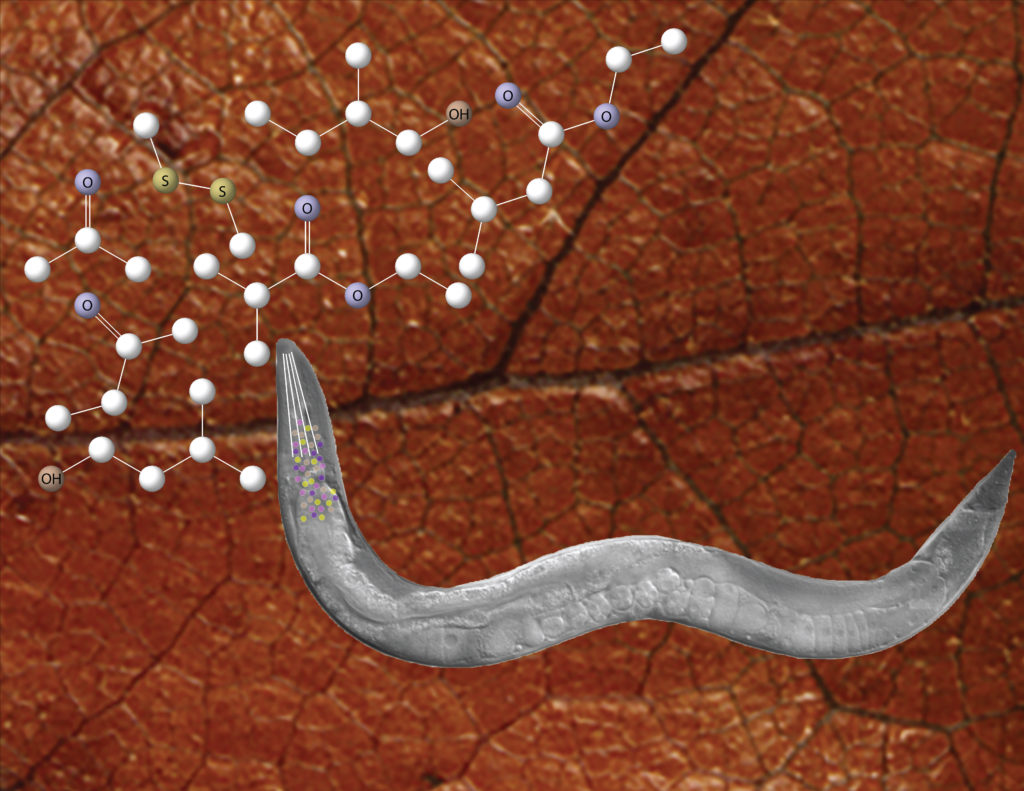Projects
In our laboratory, we study the neuronal circuitry underlying decision-making behavior in the free-living nematode, C. elegans. Specifically, we examine the preference of C. elegans for complex food odors and how genetic background and environment modify these preferences.
Recognition of Natural Odor Blends
Although a lot is known about how C. elegans responds to different pure odors, less is known about how C. elegans recognizes and discriminates among complex mixtures of volatile chemicals released by bacteria, their major food source. Does C. elegans use a single odorant or a bouquet of odorants to distinguish among different species of bacteria? We are identifying the attractive and repulsive odorants released by bacteria found in the natural habitat of C. elegans using solid-phase microextraction gas chromatography-mass spectrometry (SPME–GC-MS) in collaboration with Charles Taylor (Chemistry Department, Pomona College).
Neuronal Circuitry
We are examining the neural machinery underlying bacterial preference among a diverse set of bacterial species found in the natural environment of C. elegans. Although the neurons required for the detection of specific food-odors have been well-defined, less is known about the sensory circuits underlying the discrimination among the mixtures of odors released by bacteria.
Natural Genetic Variation
We are interested in how natural genetic variation influences behavior. Understanding the genetic basis of behavior and nervous system function is particularly relevant for the diagnosis and treatment of inherited human neurological disorders. Although a few of these disorders have been mapped to single genes, many are likely to have both a complex genetic basis and underlying biology. We have found a difference in the food preference behavior between two strains of the nematode Caenorhabditis elegans and that this difference has a complex genetic basis involving several genetic loci. We are continuing to study this complexity.
Publications
(*denotes Pomona College undergraduate)
*Chai VZ, *Farajzadeh T, *Meng Y, *Lo SB, *Asaed TA, Taylor CJ, and Glater EE. 2024. Chemical basis of microbiome preference in the nematode C. elegans. 2024. Scientific Reports. doi:10.1038/s41598-024-51533-6
Katzen A, Chung HK, Harbaugh WT, Della Iacono C, Jackson N, Glater EE, Taylor CJ, Yu SK, Flavell SW, Glimcher P, Andreoni J, and Lockery SR. 2023. The nematode worm C. elegans chooses between bacterial foods as if maximizing economic utility. Elife. 2023 Apr 25;12:e69779. doi: 10.7554/eLife.69779. PMID: 37096663
Glater, EE. 2022. The Basics of Setting up Successful Teaching Labs and Short-term Projects with C. elegans. In C. elegans Methods and Applications. 3rd edition; Eds: Haspel G, Hart AC; Pub. Springer/Nature; New York. DOI: 10.1007/978-1-0716-2180-6_2.
*Worthy SE, *Haynes L, *Chambers M, *Bethune D, *Kan E, *Chung K, *Ota R, Taylor CJ and Glater EE. Identification of attractive odorants released by preferred bacterial food found in the natural habitats of C. elegans. 2018. PLoS ONE. 13:e0201158.
Pokala N and Glater EE. 2018. Using optogenetics to understand neuronal mechanisms underlying behavior in C. elegans. Journal of Undergraduate Neuroscience Education. 162(2): A152-A158.
*Worthy SE, *Rojas GL, Taylor CJ and Glater EE. 2018. Identification of odor blend used by Caenorhabditis elegans for pathogen recognition. Chemical Senses. 43(3):169-180.
Glater EE, Rockman MV and Bargmann CI. 2014. Multigenic natural variation underlies Caenorhabditis elegans olfactory preference for the bacterial pathogen Serratia marcescens. G3 Genes Genomics and Genetics. 4(2): 265-276.
Glater EE and Schwarz TL. 2009. Organization and transport of mitochondria in neurons. In The New Encyclopedia of Neuroscience (Ed. Larry Squire). 903-911.
Glater EE, Megeath LJ, Stowers RS and Schwarz TL. 2006. Axonal transport of mitochondria requires milton to recruit kinesin heavy chain and is light chain independent. J Cell Biol. 173: 545-557.
